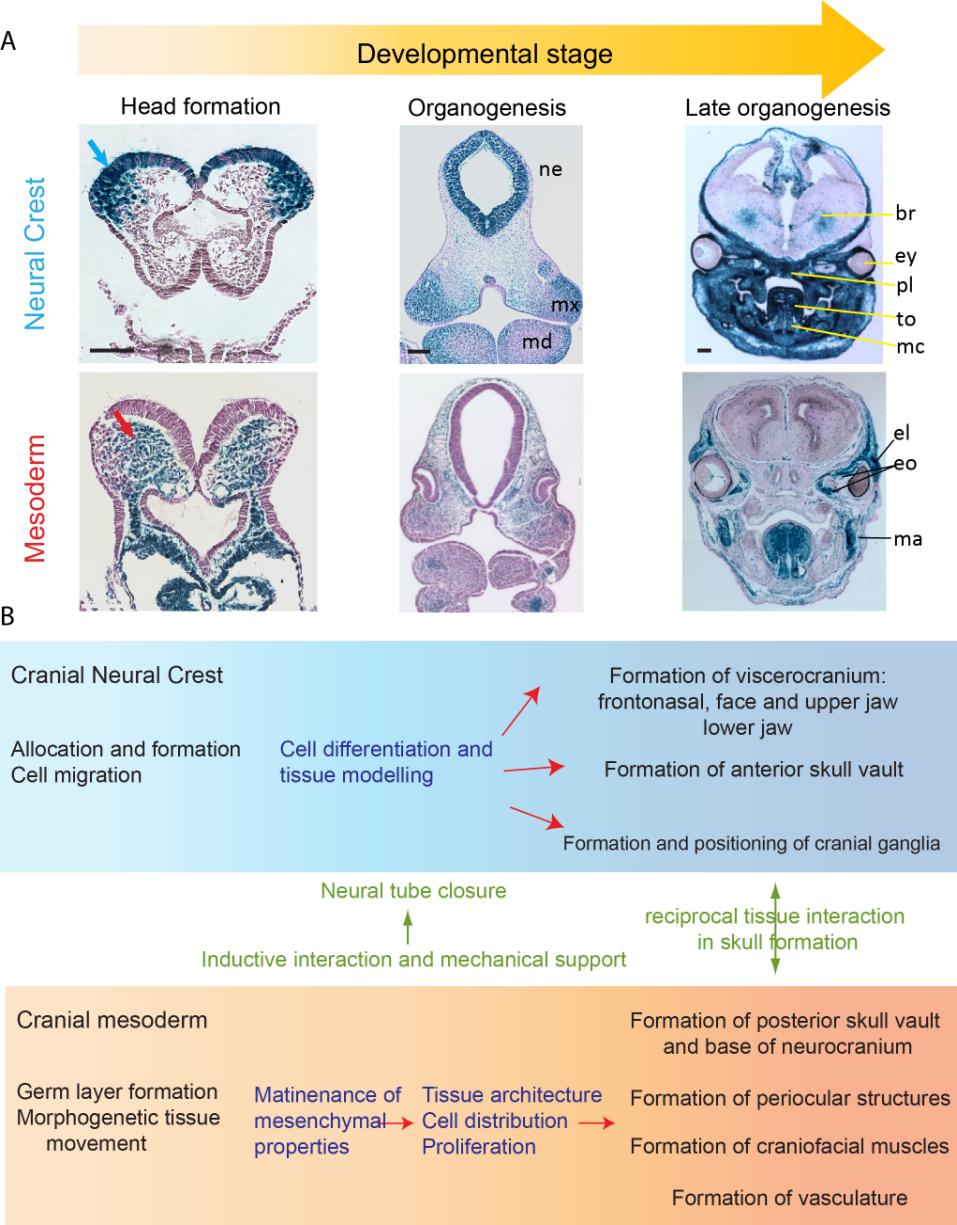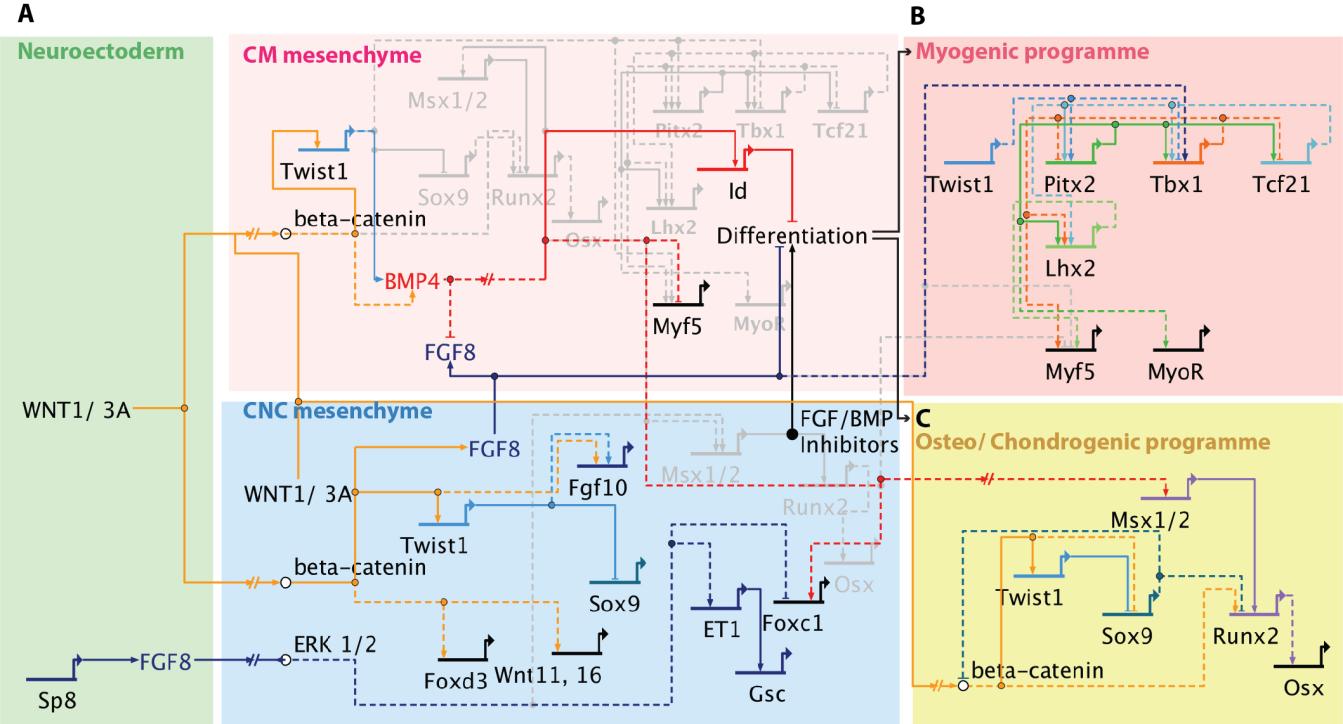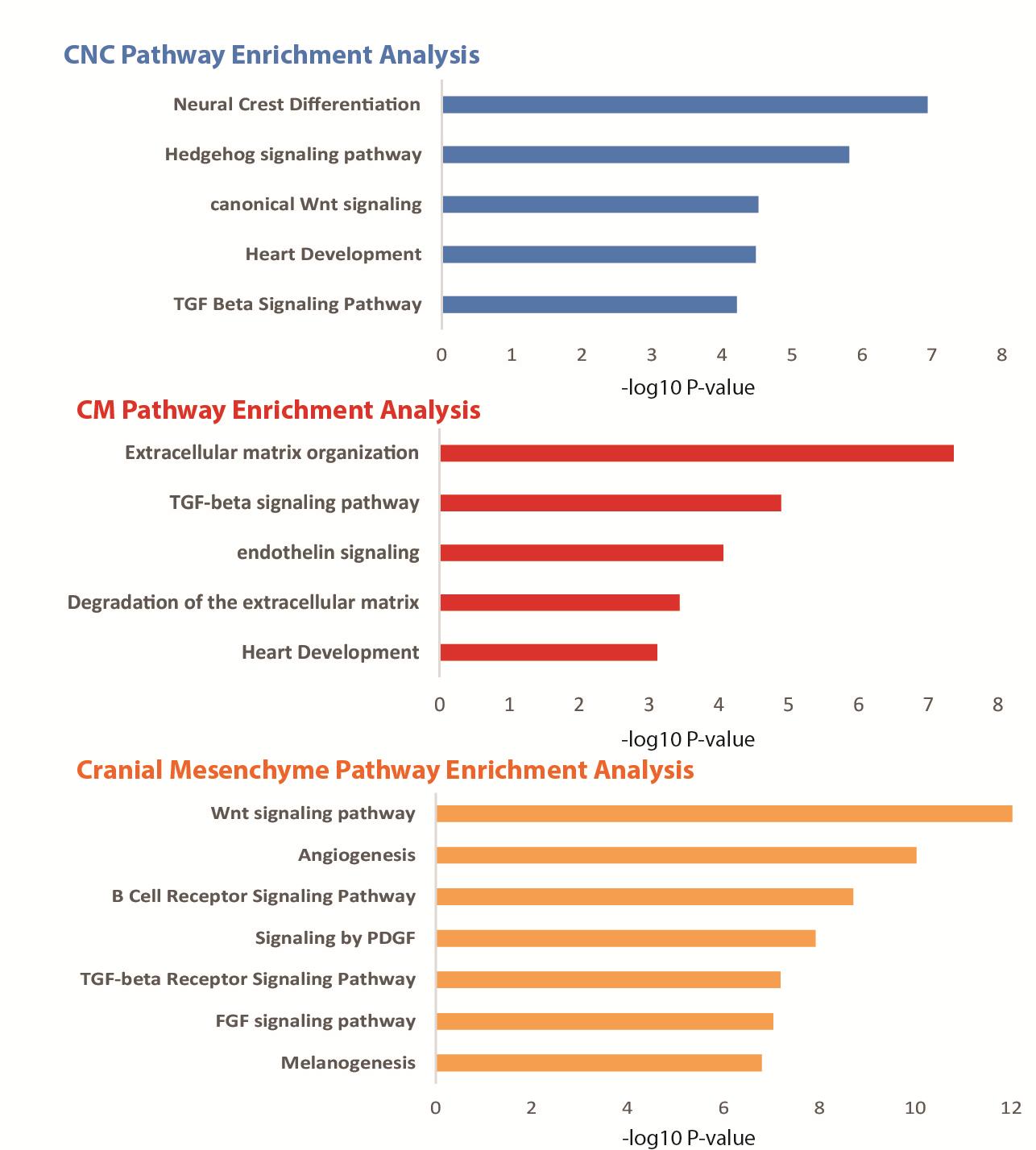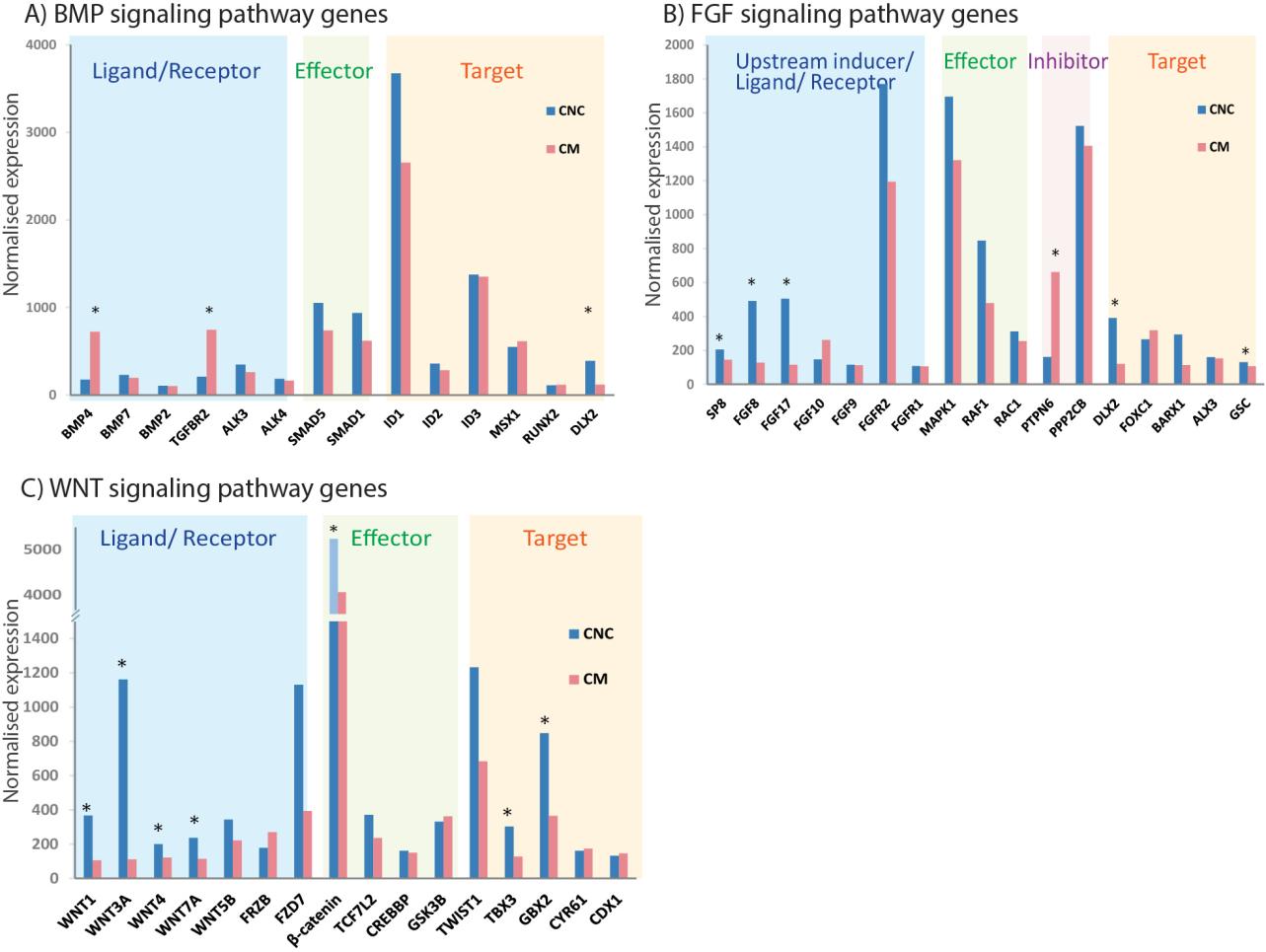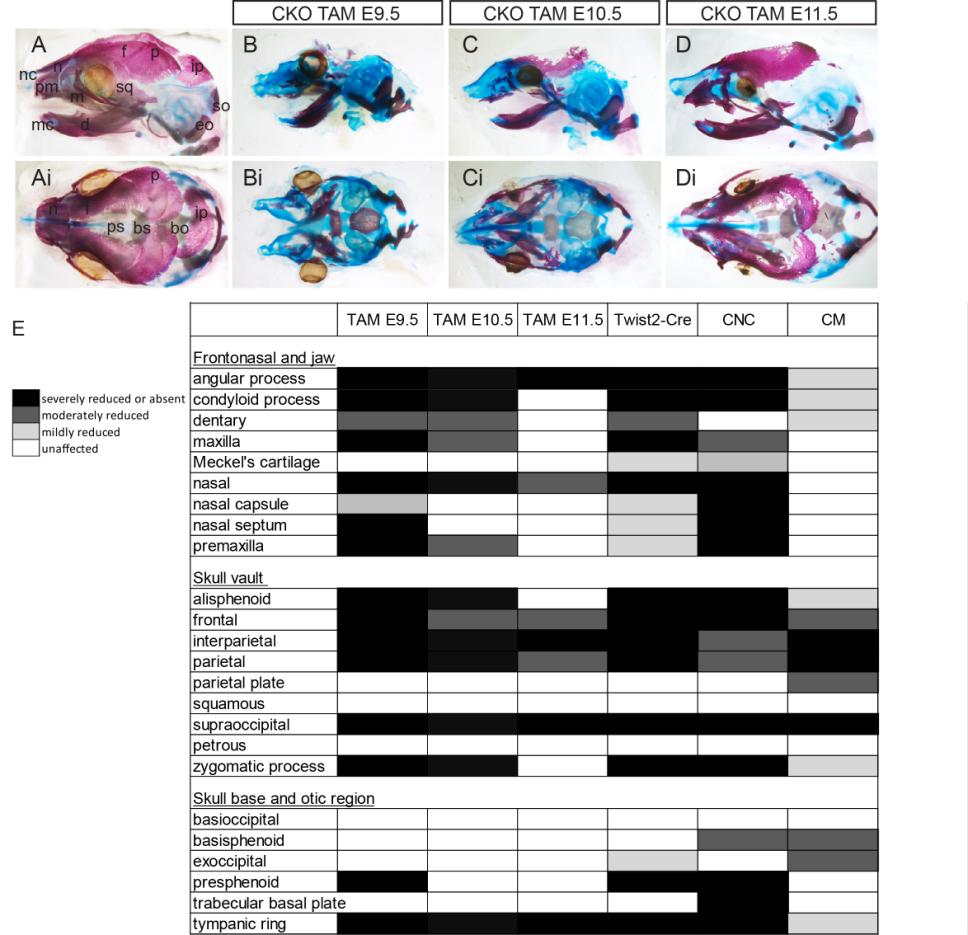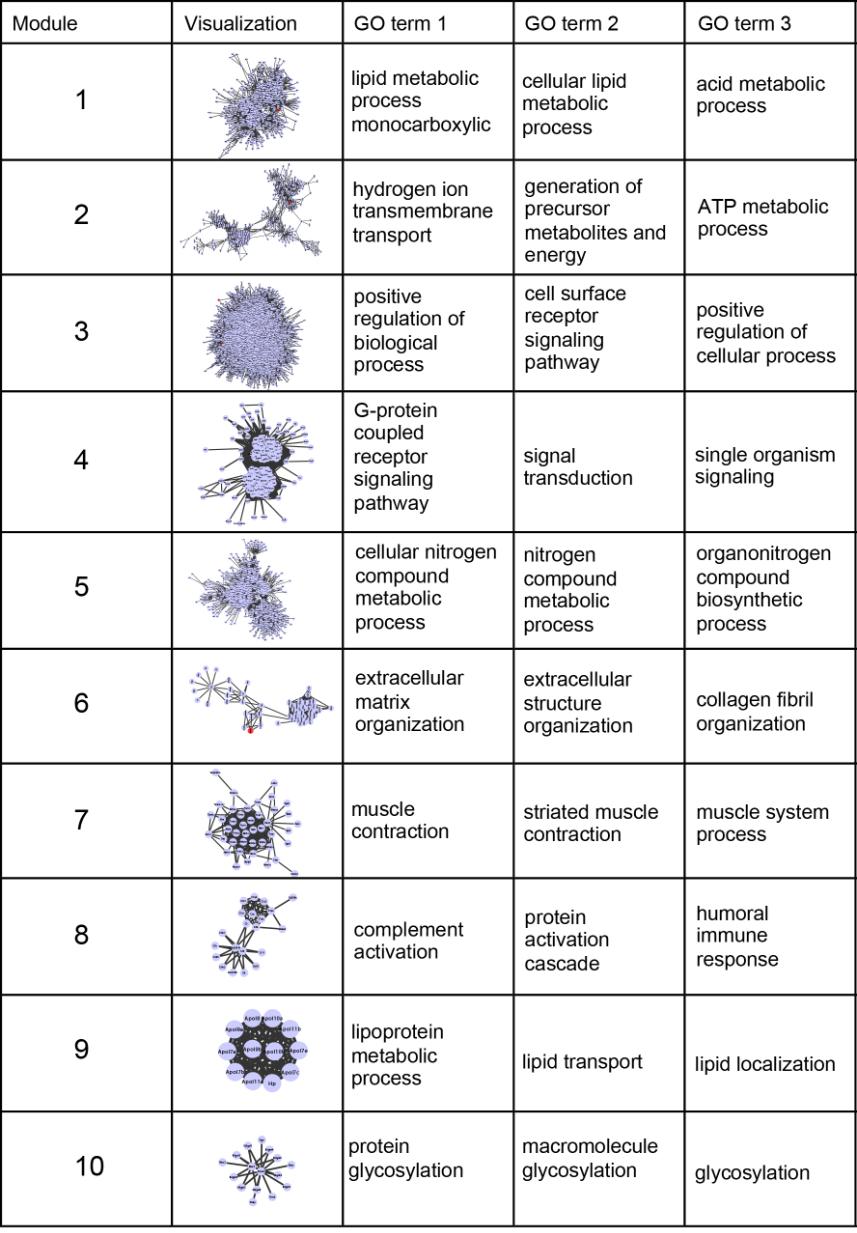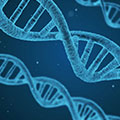1. Introduction
The embryonic head contains two skeletogenic mesenchymal cell populations that are derived separately from the cranial neural crest (CNC) and cranial mesoderm (CM) [1]. The CNC gives rise to the rostral-most tissues, including the frontal bone, nasal bones and cartilage, as well as the pigmented cells and contributes to the innervation of the head and face. The CM is the source of tissues of the posterior skull, all the head musculature and endothelial cells of the vasculature. The tissue contributions of the CNC and the functions of individual genes in its development have been extensively studied, with the widespread use of CNC-specific CRE drivers such as Wnt1-Cre that can effectively generate embryos with tissue-specific loss of function mutations (Table 1). In contrast there are few studies that focus on gene function in the CM and the role of the CM in craniofacial development (Table 1). A greater understanding of the development of the CM is of particular importance given its significant contribution to craniofacial skeleton and musculature, its influence on CNC migration, and the likely role of the CM as a supportive tissue for the morphogenesis of the cranial neural tube (Figure 1). Despite their distinct tissue origin, the two cell types establish an intimate spatial and interactive relationship during tissue morphogenesis [2,3,4] (Figure 1).
Table 1. Craniofacial phenotypes of mouse mutants in key pathway components
| Mutant genotype (f/f = floxed/floxed; GOF = gain of function) | Pathway/ component | CNC tissues affected | CM tissues affected | Reference |
| β-catenin f/f; Foxg1-Cre (facial ectoderm and neuroepithelium) | WNT signaling effector | Loss of most facial bones; mandible and tongue remains | N/A | Wang et al. 2011 |
| β-catenin f/f; Crect-Cre (early ectoderm) | WNT signaling effector | Loss of most facial bones | Bones are present, with minor defect | Reid, 2010 |
| β-catenin f/f; Wnt1-Cre or Sox10-Cre (CNC) | WNT signaling effector | Lost almost all craniofacial structure; Meckel’s cartilage remained; impaired melanocyte and sensory neuron specification | Loss of most bones; ectopic smooth muscle | Brault et al 2001; Hari et al., 2002 |
| β-catenin f/-; En1-Cre (subset of CNC and CM) | WNT signaling effector | Loss of most bones; ectopic cartilage | Loss of most bones; ectopic cartilage | Goodnough, 2012 |
| β-catenin f/f; Twist2-Cre (subset of CNC and CM) | WNT signaling effector | Reduced most bones; ectopic cartilage; synovial joint fusions | Loss of most bones; ectopic cartilage | Day et al., 2005 |
| β-catenin ex3/ex3 (GOF); Foxg1-Cre | WNT signaling effector | Absent nasal prominences and maxillary prominence | N/A | Wang et al. 2011 |
| β-catenin ex3/ex3 (GOF); Prx1-Cre (CM mesenchyme) | WNT signaling effector | Loss of posterior frontal bones | Greatly reduced parietal bone | Goodnough, 2012 |
| Wls f/f; Crect-Cre | WNT ligand transporter | Lost most bones; ectopic cartilage | Lost most bones; ectopic cartilage | Goodnough, 2014 |
| Lrp6 -/- | WNT receptor | Facial hypoplasia; cleft palate | N/A | Song et al., 2009 |
| Col2a1-Wnt14 overexpression | WNT ligand | Expanded oestrogenic zone | Expanded osteogenic zone | Day et al., 2005 |
| Apc f/f; P0-Cre (CNC- peripheral nervous system, facial mesenchyme) | WNT inhibitor | Loss of frontonasal bones; malformed maxilla and mandible | Reduced CM derived skull vault | Hasegawa et al 2001 |
| Foxd3 f/f; Wnt1-Cre; | WNT target | Loss of frontal nasal bone and cartilage; short maxilla and mandibular bone; cleft face and palate | Reduced interparietal, parietal, basal occipital bone | Teng et al 2008 |
| Sox9 f/f; Wnt1-Cre; | WNT target (inhibitory) | Reduced size of all facial bones; loss of Meckel’s cartilage , nasal capsule, inner ear ossicles and endochondral bones; | Loss of basisphenoid and presphenoid | Mori-Akiyama et al 2003 |
| Bmp4 f/f; Nestin-Cre | BMP ligand | Cleft lip (low penetrance); delayed palatal fusion | N/A | Liu, 2005 |
| Alk2 f/f; Wnt1-Cre | BMP receptor | Absent anterior Meckel’s cartilage and posterior part of zygomatic bone; reduced frontal bone, mandible; cleft palate | N/A | Dudas et al 2004 |
| Alk2 f/f; Nestin-Cre (first branchial arch specific) | BMP receptor | Cleft lip and palate; arrested development of palatal shelf and maxillary molar | N/A | Liu, 2005 |
| Alk5 f/f; Wnt1-Cre: | BMP receptor | Skull vault defect, maxilla defects | Skull vault defect | Dudas et al 2006, Zhao et al 2007 |
| Smad4 f/f; Wnt1-Cre | BMP signaling effector | Severely affected first branchial arch, lack of midline fusion in mandible and maxilla | N/A | Ko et al 2007 |
| Msx1 f/f; Msx2 f/f; Wnt1-Cre; | BMP targets | Cleft palate; foreshortened mandible and maxilla; enlarged frontal bone | Reduced parietal bones; clefting of interparietal bone | Roybal, et al., 2010 |
| Fgf8 neo/- | FGF ligand | Severely reduced maxilla, mandible and palates; missing Merkel's cartilage | Hypoplastic branchial arches | Abu-Issa et al., 2002; Griffin et al., 2013 |
| Fgf8 f/f; Nestin-Cre; | FGF ligand | Loss of most BA1 structures: mandible, maxilla and Merkel’s cartilage; only reminiscent distal structures left | Loss of most BA1 structures; slightly reduced parietal and interparietal bones | Trumpp et al., 1999 |
| Fgfr1f/f; Wnt1-Cre; | FGF receptor | Cleft lip, palate | N/A | Wang et al., 2013a |
| Fgfr2f/f; Wnt1-Cre; | FGF receptor | No anticipated mid-facial defects | N/A | Valverde-Franco et al., 2004 |
| Fgfr2f/f; Twist2-Cre; | FGF receptor | Domed-shaped skull | Open occipital arch; Failed closure of midline suture | Yu et al., 2003 |
| Fgfr2s252w f/+; Mesp1-Cre; | FGF receptor | Foreshortened frontal and facial bones | Coronal craniosynostosis; retroflexion of skull base; Ectopic cartilage at interparietal foramen | Holmes, 2012 |
| Fgfr2s252w f/+; Wnt1-Cre; | FGF receptor | Foreshortened frontal, facial bones, palate; Synostosis of major facial bones | N/A | Holmes, 2012 |
| Erk2 f/f; Wnt1-Cre | FGF signaling effector | Mandibular and maxilla truncated; cleft palate | Absent tongue | Newbern et al 2008 |
| Sp8 f/f; Pax3-Cre (Anterior neural ridge, facial mesenchyme) | FGF upstream inducer | Loss of frontal bones; severe midfacial defects; exencephaly; cleft palate | Loss of parietal bones | Kasberg et al. 2013 |
| Sp8 f/f; Wnt1-Cre | FGF upstream inducer | No cranial phenotype | No cranial phenotype | Kasberg et al. 2013 |
| Sp8 f/f; Mesp1-Cre | FGF upstream inducer | No cranial phenotype | No cranial phenotype | Kasberg et al. 2013 |
| Spry1 OE; Wnt1-Cre | FGF inhibitor | Loss of maxilla; reduced and malformed mandible; facial clefting | Hypoplasia of skull vault elements | Yang et al 2010 |
| Tbx1 -/- | Transcription factor | N/A | BA1 myogenesis defects | Kelly et al |
| Tbx1 f/f; Mesp1-Cre | Transcription factor | Cranial Nerve: fusion of trigeminal nerve to facial nerve; hypoplasia and aberrant patterning of branchial arches | Aberrant patterning and hypoplasia of tissues derived from first and second branchial arches | Zhang, 2006 |
| Tbx1 f/f; T-Cre | Transcription factor | Reduced mandibles; loss of coronoid process and a hypoplastic angular process; missing 2nd branchial arch and stapes | Missing 2nd branchial arch | Aggarwal, 2010 |
| Pitx2 -/- | Transcription factor | N/A | Extraocular muscle dysgenesis; thickening of mesothelial layer of cornea | Kitamura et al 1999, Diehl et al 2006, Dong, 2006 |
| Pitx2 f/f; Mesp1-Cre | Transcription factor | N/A | Masseter muscle deficiency; defective myogenesis of branchial arch derivatives | Dong, 2006 |
| Pitx2 f/f ; Nestin-Cre (BA1) | Transcription factor | Loss of mandibular elements; fused mouth | N/A | Sclafani et al 2006 |
| Twist1 f/f; Wnt1-Cre | Transcription factor | Lost most bones, but mandible including Meckel’s cartilage remained; cranial nerve patterning defect; ectopic cartilage in maxilla | Loss of supraoccipital; Reduced parietal and interparietal | Bildsoe et al 2009 |
| Twist1 f/f; En1-Cre | Transcription factor | Loss of maxilla and frontonasal bones; skull vault defects | Loss of anterior parietal and interparietal bones; ectopic cartilage in posterior skull | Goodnough et al., 2012 |
| Twist1 f/f; Mesp1-Cre | Transcription factor | Greatly reduced all CNC-derived bones; reduced nasal cartilage | Loss of most bones and cartilage, except basioccipital; loss of extraocular muscle and upper eyelid; irregular patterns of posterior head muscle | Bildsoe et al., 2013 |
| Twist1 f/f; Twist2-Cre | Transcription factor | Loss of most bones | Reduced and malformed bones; loss of extraocular muscle | Goodnough et al., 2015 |
| Pdgfra f/f; Wnt1-Cre | Transcription factor | Midline cleft, maxilla abnormal, skull base defects | Reduced size of skull vault | Tallquist and Soriano 2003 |
2. Tissue origins of the skull and face
The tissue contributions of the CNC and CM in the mouse have been studied using reporters of tissue-specific CRE recombinase activity and clonal analysis. Initially, the cranial mesenchyme is entirely derived from CM (head fold formation stage E 8.5-9.5; Figure 1). The CNC migrates into the lateral regions, subjacent to the ectoderm and populates the frontonasal mesenchyme and the superficial mesenchymal tissue domain of the branchial arches (BAs). The CM contributes to the tissue in the core of the branchial arches and the pre-chordal mesenchyme beneath the forebrain. The CNC and the CM, which will form the mandible and the branchiomeric muscles respectively, migrate and co-localise in the first branchial arch (BA1) [7] (Organogenesis E 9.5-E 11). In the skull base, most of the skeletal tissues anterior to the basioccipital are derived from the CNC, with those posterior being derived from the CM. The acrochordal cartilage, which lies between the basioccipital and the basisphenoid shows dual tissue origin [5]. The exception is the hypochiasmatic cartilage, which lies adjacent to the orbital cartilage. Although surrounded by CNC- derived elements, this cartilage is derived from the CM [5], and is closely associated with the extraocular muscles, which are likely to be derived from a combination of the mesoderm from the first branchial arch and pre-chordal mesoderm [6] (Late organogenesis stage E 11+, Figure 1). The skull vault and frontonasal tissues display a similar rostral-caudal division in tissue origin, with the division lying between the frontal and parietal bones [7].
3. The cranial mesoderm and the cranial myogenic program
The mesoderm that is derived from the epiblast during gastrulation forms the musculature, vascular system and the majority of the posterior cranial skeleton [2,8,9]. The molecular profile of the CM is distinct from the trunk mesoderm, despite a lack of physical boundary between the two, as revealed by marker analysis in chick embryos [10]. Another unique feature of head mesoderm is the lack of clear segmentation. Metameric structures within the cranial paraxial mesoderm (the somitomeres) have been identified in the avian and mouse embryos [11,12]. Somitomeres are visible as concentric arrangements of the superficial cells in the CM, whichcan be observed when the overlying ectoderm is removed. However, unlike the somites in the trunk mesoderm, somitomeres do not correlate with lineage propensity, spatial properties of the cell, nor marker gene expression [2]. The developmental significance of somitomeres is therefore uncertain. Molecular markers marking the di-mesencephalon territories are a more reliable indicator of regionalization within the cranial mesoderm [10].
Most studies of mesoderm development in the head have focused on the development of the musculature. The myogenic program in the head is significantly delayed compared to the trunk and is under the direction of a unique group of myogenic factors (MRF) [13,14,15]. In the trunk mesoderm, Pax3 initiates the myogenic program and upregulates MRFs that promote differentiation of myotubes. In the CM, where Pax3 is not expressed, Tbx1 and Pitx2 specify the muscle in the head[16,17]. Pitx2 shares an expression domain in the first branchial arch with Tbx1, yet it is uniquely required for formation of the extraocular muscles [18,19,20]. They cooperatively induce the early myogenic factors Tcf21 (Capsulin), Msc (MyoR), and Lhx2, which subsequently induces the expression of Myf5 and Myod1 [15,17] (Summarized in Figure 2B). Embryonic expression pattern of genes discussed in this review can be found in EMAGE gene expression database [21] (http://www.emouseatlas.org/emage/).
Mesodermal Tbx1 is necessary and sufficient to induce MRF and generate the brachiomeric muscles in BA1 and BA2 [22] (Table 1,Figure 2B). Impairment of branchiomeric muscle seen in Tbx1 deficient embryos can be fully rescued by Mesp1-Cre mediated re-expression of Tbx1, confirming a tissue-autonomous requirement in the CM. Tbx1 also has a non-cell autonomous role in guiding the migration of CNC [22,23]. Hypoplastic mandibular bone and missing cartilage including the ear and stapes occur as a result of the loss of BA2 localization of CNC mesenchyme. In the absence of mesodermal Tbx1, CNC cells from rhombomere 4 are misplaced into BA1, and BA2 fails to form [23]. Deregulation of FGF and BMP target genes in the Tbx1 mesoderm-specific mutant might explain the non-cell autonomous disruption of the formation of the CNC-derived mandible.
Twist1 has been shown as a negative regulator of myogenesis in cell cultures [24,25,26]. However, in mesoderm-specific Twist1 mutant embryos, there is no increase in muscle mass, despite the upregulation of the cranial muscle specifier Tbx1 [27]. Instead, the extraocular muscles are specifically affected and the upper eyelids are missing and the posterior cranial muscles are mis-patterned in mesoderm-specific loss-of-function mutants [27,28]. Consistent with the extraocular muscle defect, expression of Pitx2 and Myf5 is reduced in the periocular tissue of mesoderm-specific Twist1 mutants. In summary, Twist1 acts upstream of Tbx1 and Pitx2 and facilitates extraocular muscle formation by inducing Pitx2 while repressing Tbx1 (Figure 2B).
The pre-myogenic mesodermal mesenchyme grows in close proximity to the CNC, as well as the pharyngeal ectoderm and endoderm. It is subject to signaling from these surrounding tissues, including WNT from the neural tube and BMP both from neural ectoderm and the CM. Myogenic induction is facilitated by repression of these signals by BMP and WNT inhibitors from the neural crest cells [13].
4. Transcriptomic comparisons between CNC and CM reveal regional signaling interactions
We have conducted a microarray-based comparison of the gene expression profiles of the CNC and CM, using cells isolated from E 9.5 head tissues, sorted for the expression of a GFP-reporter activated by Wnt1-Cre and Mesp1-Cre respectively (H. Bildsoe et al, unpublished). The list of differentially expressed genes was filtered to include only those that are known to be associated with developmental craniofacial abnormalities. ToppGene (http://toppgene.cchmc.org) was used to detect functional enrichment. As expected, the CNC-enriched pathways are well-studied processes important for the differentiation and patterning of CNC tissues, including NC differentiation, canonical WNT signaling, SHH signaling and TGFβ signaling (Figure 3). In the CM, genes involved in extracellular matrix (ECM) organisation are over-represented. Also identified is TGFβ signaling, which regulates ECM organization and also myogenic and skeletogenic programmes in the CM[30,31]. Endothelin signaling, which is likely to be associated with vascular development was also enriched in the mesoderm. The presence of heart development genes in the lists points to a conservation of developmental programmes for the head and heart mesenchyme [32]. Among the pathways that are enriched in both head mesenchyme cell populations are TGFβ-related, FGF and WNT signaling (Figure 3). In this review, we will concentrate on how these pathways are utilised in the head mesenchyme, and the impact of the interaction between the CM and the CNC and neighbouring ectoderm and endoderm tissues on craniofacial development. Signaling pathways exert their influences at multiple stages of development. Here, we will concentrate on signaling that affects the early craniofacial organogenesis (nominally E9.5-E11.5 in the mouse, Figure 1), in which perturbation of pathways that affect cell survival, proliferation and specification as well as tissue patterning and differentiation are likely to have dramatic effects later on development of muscular and skeletal structures. The studies referred to in Table 1 are primarily concerned with gene ablation in progenitor cells (such as Wnt1-Cre for early migratory CNC and Mesp1-Cre for early anterior mesoderm as it exits the primitive streak). Although the primary defects of mouse mutants are likely to be due to early events, later functions of target genes during tissue differentiation cannot be discounted.
In addition, when interpreting data derived from Cre-driven conditional mutations, some consideration must be given to the fidelity of Cre expression and the possibility that the effects of the Cre transgene are not neutral. For example, although the activity of the original and widely used Wnt1-Cre transgene appears to reflect the expression of the endogenous Wnt1 gene in the dorsal neural tube, resulting in efficient deletion of target genes in the neural crest, other neural crest-expressed Cre transgenes (eg: HtPA-Cre) show highly variable activity [9]. Recently, Lewis and colleagues showed that the original Wnt1-Cre transgene ectopically activates Wnt1 in the midbrain, leading to enlargement of the midbrain, which is associated with ectopic WNT signalling [33]. An alternative reporter, Wnt1-Cre2, which recapitulates Wnt1-restricted CRE recombinase activity but not the ectopic Wnt1 expression, was recommended. However, conditional mutants in the Hippo Signaling pathway generated using the two reporter lines displayed similar lethality and craniofacial phenotypes, except for the neural tube closure phenotype[34]. Our experience with Mesp1-Cre as a driver for mesodermal Cre activity demonstrated the expected temporal and spatial specificity in Cre expression, as assessed by both Mesp1-Cre-driven lacZ reporter staining and Cre transcript expression [27]. In conclusion, artefacts in Cre reporter lines do exist, but they are still valid tools in dissecting the tissue-specific gene functions, especially when multiple reporter lines can be assessed in parallel.
5. Cranial mesoderm is a source of BMP signaling in craniofacial development
BMPs are members of the TGFβ superfamily of signaling molecules with diverse roles in development, including tissue patterning, germ layer formation and skeletal development. Bmp4 and Bmp7 are able to replace neural ectoderm for the induction of CNC cells [35], indicating that the neural ectoderm is an important source of BMP signaling to the CNC. Bmp4 is required for the maintenance, migration and differentiation of CNC cells [36]. Our data suggest that during early organogenesis, Bmp4 is also expressed in the CM-derived cranial mesenchyme at a significantly higher level than in the CNC, whereas other ligands, including Bmp2, 5, 7, are expressed at low to almost undetectable levels in both CNC and CM (Figure 4A). Expression of BMP receptors and target genes is at similar level in CM and CNC-derived cells (Figure 4A), suggesting that both pop
ulations are capable of responding to BMP signaling. CM-derived Bmp4 may therefore act autonomously on the CM and non-autonomously on the CNC. The expression of Bmp4 in CM suggests the possibility that the CM is another BMP4 signaling centre that influences CNC development, in addition to the ectoderm (Figure 2A).
BMP signaling acts autonomously in the CM to regulate myogenic and skeletogenic programs, as revealed by conditional mutagenesis of Bmp4 or downstream signal transduction factors [37,38,39,40,41,42] (Table 1; Figure 4A). Evidence for the osteogenic effects of Bmp4 also comes from studies of cultured progenitor cells from cranial sutures, in which application of exogenous Bmp4 protein is sufficient to induce Msx genes and ossification [43]. Although these experiments model a later stage of development, they illustrate the ability of BMP signaling to influence the fate of mesenchyme progenitor cells.
Unfortunately, studies on conditional knockout or over-activation of BMP signaling in the mesoderm are lacking. It has been shown that Msx1 and 2 are transcriptional targets of the Bmp4-activated signaling pathway [43,44]. Loss of function of Msx1 and 2 from the CNC reproduced the hypoplastic jaw structures seen in BMP signaling mutants [42]. Downstream of Msx genes is Runx2, which activates an osteogenic transcriptional program [42] and Bmp4 itself, further amplifying the signal.
BMP signaling is inhibitory to cranial muscle formation, in contrast to its function for trunk muscles. Expansion of Bmp4 expression at the beginning of organogenesis in the brachial arch coincides with the loss of facial muscles at later stages, in mice lacking the muscle specifiers, Tbx1 and Pitx2 [19,22,23,45]. BMP4 signaling may curtail the myogenic process by targeting the myogenic regulatory factors. A plausible mechanism of myogenic repression of Bmp4 is through direct induction of Id genes [42], which compete with muscle-specific basic helix-loop-helix factors for dimerization with E-proteins and thus prevent their activity as myogenic factors [46,47].
6. Differential activities of FGF signaling in CM and CNC
6.1. Tissue-specificity of signaling function
FGF signaling was identified as a pathway enriched globally in the cranial mesenchyme (Figure 4B). Signaling activity is regulated at multiple levels, including the availability of ligand and receptors, the presence of inhibitory factors and upstream inductive or repressive signals. Closer analysis of the data reveals that most FGF ligands, receptors and intracellular effectors are expressed at similar levels in two tissues of interest, yet Fgf8 and the closely related ligand Fgf17 are preferentially expressed in the CNC (Figure 4B). Some known downstream targets that are expressed in the head have higher expression level in the CNC, including Dlx2 and Gsc.
Fgf8 and 10 encode ligands that are critical for the development of the facial primordia and the skull, and their expression is frequently perturbed in mutants of other craniofacial genes[14,15,48,49]. Whole mount in situ hybridization (WISH) analysis indicates that Fgf8 is highly expressed in the facial ectoderm initially, and subsequently becomes restricted to nasal and oral edges [50]. Our microarray data suggest that Fgf8 is also expressed in the CNC at E9.5 (Figure 4B). Fgfr1 and 2 transcripts are found to be overlapping in the cranial mesenchyme and ectoderm [51]. In agreement with these findings, we detected high levels of Fgfr2 in both CM and CNC derived head tissues in E9.5 embryos (Figure 4B).
6.2. Impact on skeletogenesis
The level of FGF signaling activity needs to be finely controlled. Dosage-dependent abnormalities related to the level of Fgf8 have been reported [52,53]. Fgf8 neo/neo(hypomorphic) mutants display moderate nasal and basal capsule defects. Fgf8 neo/- mutants, presumably expressing less Fgf8, showed more severe hypoplasia of frontonasal and maxilla bone and cartilage, with almost fully penetrant midfacial clefting [52]. When Fgf8 function is completely abolished, development is arrested at gastrulation. Removal of Fgfr1 from the CNC leads to cleft palate and lip, accompanied by a proliferation defect in these regions [54]. CNC-specific ablation of the Fgf8 upstream factor Sp8 or overexpression of the FGF antagonist Spry1 has generated disruption similar to Fgf8 and Fgfr1 mutants [55,56]. Notably, CNC-specific knockout of Sp8 also impairs parietal bone development
CM-derived skull elements are less affected by the disruption of FGF signaling than the CNC- derived structures. Mesoderm-specific knockout mutants display only mild abnormalities of CM-derived bones [57]. Intriguingly, constitutive activation of Fgfr2 in the mesoderm does not affect growth of bones of mesoderm origin, yet it induces severe shortening in all CNC-derived skull structures and craniosynostosis through an unknown mechanism [58]. Over-activated FGF signaling in the CNC itself induces a similar shortening of facial bones due to arrested osteogenesis [58]. The lack of response of CM tissues to loss or gain of FGF receptor activities suggests that the FGF signaling has lower activity level in the CM compared to CNC, as also indicated in our transcriptome analysis. The inhibitory factor that keeps the signaling activity in check is likely to be downstream of receptor activation. BMP signaling is shown to antagonize FGF signaling in BA derived tissues [59,60,61]. The high level of Bmp4 expression in the cranial mesoderm might indicate a strong repression of FGF activity by BMP signaling (Figure 2A).
6.3. Impact on myogenesis
In cell cultures and chick myoblasts, FGF delays differentiation while promoting proliferation[61,62]. Chick studies have shown that FGFs emanating from the neural ectoderm keeps the mesoderm-derived myoblasts in a proliferative state [14]. In mouse branchial arch muscle development, Fgf8 also supports the proliferative state over differentiation after myoblast specification[63], whereas blocking pERK nuclear transport (and consequently the response to FGF signaling) in mouse branchial arch myoblast cell culture is sufficient to reduce cell proliferation while initiating myogenic differentiation [14,64]. In support of this, excess FGF signaling activity in Spry1/2 mutant myoblasts results in an expansion of the proliferative population when compared with wild-type counterparts [14,64]. However, loss of Fgf8 at early organogenesis effectively abolishes the formation of Tbx1 expressionzone and BA that later forms the facial muscles, indicating an earlier role of Fgf8 in patterning of facial primordial [52,65]. Ablation of the CNC by removal of the dorsal neural tube in mouse embryos results in increased proliferation and delayed differentiation in the BA mesoderm, which is associated with increased Fgf8 expression in the ectoderm [66]. This suggests that the CNC influences myogenic differentiation of the CM indirectly, via regulation of Fgf8 expression in the overlying ectoderm.
7. The WNT signaling pathway interacts with BMP signaling and TWIST1
WNT signaling plays critical roles in the generation, migration, and proliferation of CNC cells[67]. CNC cells are enriched in WNT signaling components and WNT signaling also stands out as the most enriched pathway in head mesenchyme in general (Figure 3). The expression of major components in this pathway (Figure 4C) shows preferential activation of most WNT ligand genes, the effector β-catenin and some target genes in the CNC, but there is no significant difference in receptor expression between CNC and CM. This suggests that the CM is capable of responding to WNT signaling mediated by the ligands sourced from the surrounding CNC and surface ectoderm.
Conditional mutation in WNT components results in the most drastic loss of cranial bones among mutants of the three signaling pathways [1,68,69,70,71,72] (Table 1). CNC mutants display the most severe defects, including the absence of almost all head structures, followed by various degrees of skeletal defects in ectoderm and CM mutants [1,68,69,70,71,72] (Table 1). Wntless (WNT ligand transporter) conditional knock out in the ectoderm leads to loss of majority of the skull [70]. As indicated above, the ectoderm is the major source of WNT ligands, which acts on the adjacent CNC-derived mesenchyme. Signaling activity in the CM might be limited by the availability of ligand from surrounding tissues.
The size of the FGF signaling domain is tightly correlated with level of WNT activity. The expression domain of FGF ligands is diminished in the facial ectoderm of WNT loss of function mutants and expanded in mutants with overactivated WNT signaling [71,73]. Supporting this, Tcf/Lef binding sites are present in the Fgf8 gene [71,74]. Following diminished FGF signaling, severe cell death and facial deformation, frequently seen in FGF mutants, was also found in WNT mutants at the beginning of organogenesis.
In addition to loss of bones, ectopic cartilage forms following WNT inactivation. Osteogenic progenitors are diverted into chondrogenesis in the absence of WNT signals [69,70,75]. In contrast, exogenous Wnt3a or overexpression of ß-catenin in chondrogenic cell lines or limb mesenchyme blocks cartilage formation [76]. In addition, WNT antagonists, Sfrp2 and Sfrp3, are upregulated in the pre-chondrogenic mesenchyme [77,78], further supporting the notion that WNT signaling antagonizes chondrogenesis. WNT signals repress chondrogenesis by counteracting Sox9, the principal regulator of chondrogenesis. Overexpression of Sox9 inhibits osteogenesis in vivo, most likely via down-regulation of Runx2 [79,80,81]. Sox9 physically interacts with Runx2 and ß-catenin and triggers their degradation [79,82]. At the same time, the interaction of ß-catenin with Sox9 leads to the degradation of Sox9 itself. In addition, the WNT signaling responsive transcription factor Twist1 is able to repress Sox9 expression by targeting chromatin in the Sox9 3’ UTR in chromatin [69].
As well as blocking the chondrogenic pathway, WNT signaling promotes bone morphogenesis, as demonstrated by its requirement in expression of osteogenic differentiation markers Msx2, Runx2 and Osx [70,75]. This might be an indirect effect of WNT induction of BMP ligands. Bmp4 is downstream of the WNT pathway in cranial and heart mesenchyme [70,73]. The two signaling pathways might be bridged partially by Twist1, a direct target of ß-catenin [69,28]. Osteogenic calvaria explants deprived of Twist1 function lose Wnt3a responsiveness and osteogenesis is impaired. Further, loss of Twist1 in the CM and/or the CNC recapitulated the loss of bone defects of WNT mutants [9,27,69,70] (Figure 5). Underlying the skull defects is loss of the BMP target Msx2, and Runx2 in the facial bones [9]. Ting and colleagues [83] described abnormal BMP signaling activity in Twist1+/− mutants skull suture, revealed by reduced but more dispersed pSmad 1/5/8 staining at the osteogenic boundary. ChIP-seq experiments in a human mammary cell line further indicate that Twist1 directly activates BMP4 [84].
The constitutive activation of ß-catenin also leads to a dramatic loss of bones, yet via a distinct mechanism [44,69,75]. The phenotype is partly attributed to the mis-specification of osteoprogenitor mesenchyme into sensory neurons [85]. Overall, these results imply that a moderate level of WNT activity is required for osteogenic differentiation and cell survival, while strong WNT activity inhibits lineage commitment of osteoprogenitors and favors the neuronal lineage.
8. TWIST1 is a mesenchymal maintenance factor in the cranial mesoderm
The importance of the ECM production and remodeling is underlined by the overrepresentation of genes that encode ECM components and ECM remodeling factors in CM cells (Figure 3). Nearly 20% of the CM-enriched genes are involved in some aspect of mesenchymal cell characteristics. Our previous work on Twist1 has revealed a pivotal role of Twist1 in mesenchymal cell maintenance in vivo. Our workon constitutive and conditional deletion mutants of Twist1 described a unique craniofacial phenotype related to this process, apart from other head tissue formation defects aforementioned.
Constitutive loss of Twist1 results in the failure to close the cephalic neural tube, hypoplasia of BA1 and demise of the embryo before E11.5 [86,87]. Since Twist1 is expressed in CNC and CM-derived cells, the lineage-specific origins of this phenotype cannot be identified in null mutants. Twist1 transcript is detectable in the mesoderm during gastrulation, but Twist1 protein has not been detected until early somite stages [27,88]. Twist1 is absent from the mesodermal core of the mandible, from which the majority of the cranial muscles are derived [27,66]. Expression persists in the CM that gives rise to the posterior skull and extraocular muscles [27]. Twist1 is also detected in CNC cells and CNC-derived tissues in the frontonasal, maxilla and mandibular tissues.
8.1. Role of Twist1 in neural crest cells
Twist1 has been conditionally inactivated in the CNC [9], specifically in the mandibular arch CNC [22], in the CM [27] and in both CNC and CM populations [28,89,90] (Figure 5). In CNC cells, Twist1 is required for cell survival and to maintain the capacity to differentiate into bone and cartilage [9,28]. The consequence of these defects is a lack of neural crest-derived bones and cartilage, as well as the CNC-derived dura mater that underlies the skull, and other CNC-derived tissues such as the cornea. As a result, CM-derived skeletal elements, which require interactions with the dura, are also affected. Although the mandible is formed in the absence of Twist1, it is truncated at the proximal end, and articulation with the cranium is not established [9,91].
8.2. Role of Twist1 in the mesoderm
When Twist1 was specifically ablated in the CM, skull development was also severely impaired, but this was not due to excessive cell death [27]. Although Twist1-deficient CM cells display a slightly reduced rate of proliferation, the most pervasive defect was a change in the distribution of the CM cells. Twist1-deficient CM cells become unevenly spread throughout the mesodermal domain and form cyst-like clumps. Cell in these clumps display polarization of the actin cytoskeleton and express E-cadherin, both of which are characteristics of epithelial cells. This accompanies a reduction in the expression of mesenchyme-specific genes, including Snai2 and Pdgfra. This requirement for Twist1 in maintaining cells in a mesenchymal state, appears to be specific to the CM, since no disruption to mesenchymal cell phenotypes were observed in surviving Twist1-deficient CNC cells [9], or in limb-bud mesenchyme that lacks Twist1, apart from a moderate change in cell density [27].
This primary effect of Twist1 in regulating the mesenchymal characters in the CM extends to other aspects of cranial tissue morphogenesis, including neural tube closure, CM cell migration and response to the inductive signals for differentiation. In CM-specific Twist1 mutant embryos, but not CNC-specific mutants, the cephalic neural tube fails to close. This points to a vital role of the CM in supporting neural tube morphogenesis. It is known that the cranial mesenchyme supports neural tube elevation through changes to the rigidity and volume occupied by the extracellular matrix [92].
CM cells may also be impaired in their ability to migrate, as shown by the accumulation of CM-derived cells in the lateral part of the head, and the absence of the mesoderm-derived skull bones in CM-specific Twist1 mutants [27]. Since Mesp1-Cre causes the deletion of Twist1 at mid-gastrulation, this phenotype may be generated by the physical constraints posed by the open neural tube, or may reflect an impaired innate migratory capacity [27]. Failure to form skeletal elements even when Twist1 is ablated after the closure of the neural tube suggests that Twist1-deficient CM cells are intrinsically impaired in their ability to migrate or differentiate, rather than being obstructed by the malformed neural tube (Figure 5).
It is established that, in tumor-derived cells and other cultured cells, overexpression of Twist1 can drive cells to undergo an epithelial to mesenchymal transition (EMT) [93]. Twist1-dependent maintenance of mesenchymal properties has been observed in tumor cells, including synovial sarcomas [94]. Down-regulation of Twist1 expression may, in fact, be a key step in the establishment of secondary tumors following metastasis [95]. This EMT function of Twist1 is apparently not required in embryos, since mesoderm and neural crest, cell populations that express Twist1 and that arise by EMT, are formed in Twist1-null mutant embryos [86,87].
Together, the information gleaned from phenotype studies and studies of tumor metastasis indicates that Twist1 function is important for the maintenance of mesodermal progenitor cells and regulating their morphogenetic properties.
8.3. A gene regulatory network of Twist1 transcriptional target genes in the cranial mesoderm
To decipher the molecular basis of Twist1-regulated processes, we have used microarrays to identify the changes in the transcriptome following the loss of Twist1 function in the CM, and ChIP-Seq to identify the suite of Twist1-binding sites in the genome of mesenchymal cells that over-express Twist1. By combining these two types of data we have identified putative Twist1 transcriptional targets in the CM (H. Bildsoe et al, unpublished). To explore the biological processes that are affected by Twist1 and its transcriptional targets in the cranial mesoderm, we constructed a gene regulatory network based on third neighbor protein-protein interactions of these predicted transcriptional targets. Through applying a modularity based clustering algorithm to this densely connected network, functionally relevant sub-networks (modules) were identified. The modules reveal the connection of Twist1 target genes with metabolic processes, ion and lipid transport, signaling and signal transduction, and organization of the cytoskeleton and ECM, among other functional processes (Figure 6 and Supplementary Material 1: lists of genes and the interaction in the functional modules).
The functional connection of Twist1 to the biology of the ECM and cytoskeleton is consistent with our finding that Twist1 is required for the maintenance of mesenchymal attributes of the CM[27], and provides a link from Twist1 to the biological processes that mediate cellular interactions. Twist1 targets interact with the machinery for the metabolism of lipids and carboxylic acids (Figure 6). The compendium of interacting proteins further reveals interactions with WNT ligands, suggesting that Twist may contribute to the regulation of lipid modification of WNTs, which is required for extracellular transport of these proteins [98]. Twist1 function is also connected to BMP, FGF, PDGF and WNT signaling pathways via its association with cell surface receptor signaling components, and to multiple signaling pathways via G-protein coupled signal transduction (Figure 6).
9. Conclusion
In essence, the protein network analysis shows that the key processes regulated by Twist1 and its downstream targets include those related to the secretion, detection and response to intercellular signaling and the maintenance of the mesenchymal cell states. Mesodermal Twist1 constitutes the node of a molecular hub through which multiple signaling pathways, including but not limited to BMP, FGF and WNT signaling. Through its downstream targets, Twist1 translates the signals for the CM progenitors to proliferate and differentiate and the CM to provide signaling and mechanical support to the adjacent CNC-derived tissues.
CM and CNC contribute to different sets of craniofacial tissues and are of distinct embryological and evolutionary origins. Our microarray data also show that the transcriptomes of these two mesenchymal progenitor populations are distinct from each other. CNC and CM cells intermingle to a greater degree than previously appreciated in the branchial arches of avian embryos, despite their unique tissue contributions [99], suggesting that CNC and CM have intrinsically different responses to the same environmental cues. On the other hand, when avian CNC cells are ectopically located, they can form cartilage that is normally exclusively derived from CM [100]. This suggests that cell fates of the CNC are plastic and influenced by the local signaling environment. Further studies are needed to clarify how much of the observed differences between the CNC and CM cell populations are intrinsic differences and how much can be accounted for by the environment and local interactions that influence them.
Acknowledgement
Our work was supported by the National Health and Medical Research Council (NHMRC) of Australia (Grant ID 1066832), the Australian Research Council (Grant DP 1094008) and Mr James Fairfax. HB was supported by an NHMRC Biomedical Postgraduate Scholarship and a CMRI Scholarship, and XCF is supported by the University of Sydney International Postgraduate Research Scholarship, the Australian Postgraduate Award and a CMRI Scholarship. PPLT is an NHMRC Senior Principal Research Fellow (Grant ID 1003100, 1110751).
Conflict of interest
All authors declare no conflicts of interest in this paper.









 DownLoad:
DownLoad: 